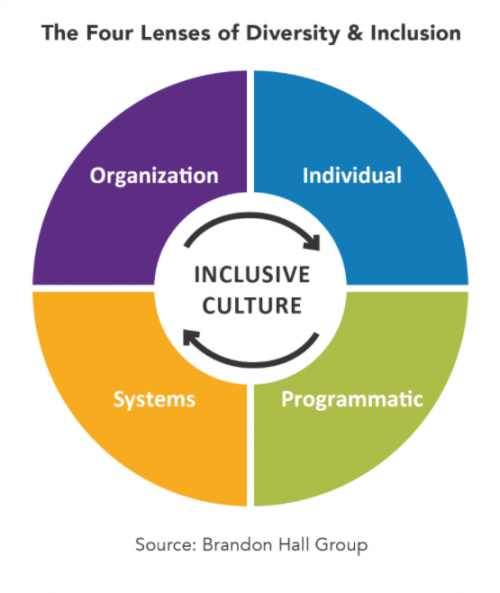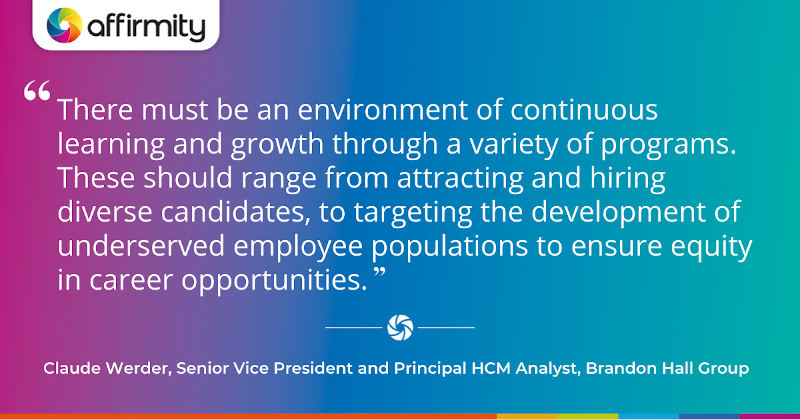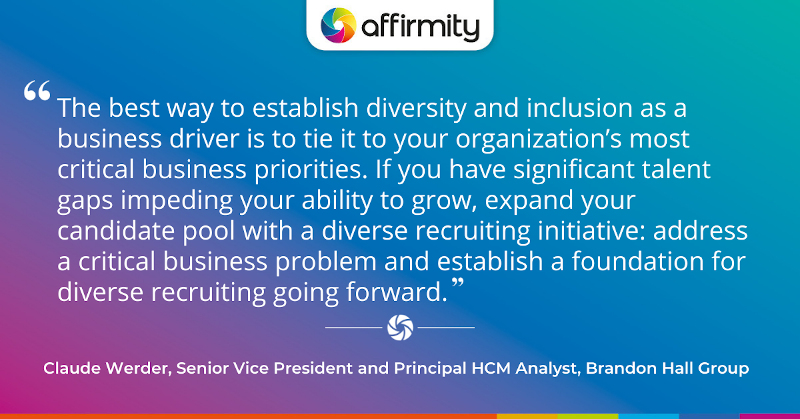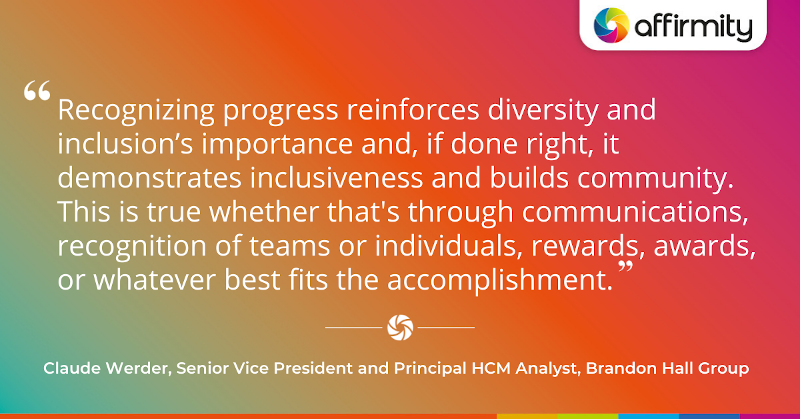A diverse workforce is critical for enhancing the competitive advantage of an organization. In this article, Claude Werder, Senior Vice President and Principal HCM Analyst at Brandon Hall Group, discusses seven strategies to build a diverse and inclusive culture that drives employee performance.
Diverse organizations find it easier to attract top talent, enter and succeed in previously untapped markets, and outperform their peers. However, without an inclusive environment, you will lose the diversity you have and fail to unlock its benefits. Inclusion is about creating connection, belonging, participation, and contribution.
Nearly 90% of organizations see D&I as an important business driver, according to Brandon Hall Group’s latest diversity and inclusion research conducted in late 2020. Three in four organizations said its importance increased due to the social justice movement that emerged from the events of 2020. But most organizations also say they are only just beginning to understand the scope and complexity of true inclusion.
Here are seven strategies to optimize your D&I efforts, based on Brandon Hall Group’s latest Diversity & Inclusion research studies:
1) Take a Holistic Approach
The key to success in Diversity & Inclusion is taking a strategic approach that touches all aspects of the organization. While D&I is a business imperative, the process is more complex than most growth initiatives because it often involves wholesale culture change or, at least, heightened awareness and new behaviors across the organization.

As the diagram above shows, a holistic approach to D&I starts by establishing values across the organization, including trust, transparency, and accountability. Those values must be communicated and demonstrated effectively and consistently. This ensures that every individual will understand the organization’s principles and their roles and responsibilities, and can thereafter apply them to everything they do.
There must be an environment of continuous learning and growth through a variety of programs. These should range from attracting and hiring diverse candidates, to targeting the development of underserved employee populations to ensure equity in career opportunities. Finally, organizations need to have systems in place to facilitate D&I. Among these systems should be governance (e.g. diversity councils that manage efforts across the enterprise) and technology tools (to connect people, collaborate and measure progress).
Additional ideas for promoting cultural awareness: ‘3 Key Ways to Build a Culturally-Aware Climate in Your Organization’.

2) Establish and Demonstrate Strong Values
Establishing values and communicating them across the enterprise is the prerequisite for diversity and inclusion as a business driver. Top executives must support, reinforce and demonstrate these values and involve other key stakeholders to establish the mission and vision from the beginning.
Values will vary by organization, but research shows that successful organizations establish:
- Trust. Employers must convince employees across the organization that they believe in a diverse and inclusive culture. To do this, they must:
- Create and sustain a safe and productive work environment.
- Create an environment where the unique attributes of each person are understood, valued, respected, and utilized.
- Offer equal opportunities for career growth.
- Evaluate and reward performance equitably.
- Demonstrate corporate responsibility, such as supporting the communities and markets they serve.
- Transparency. The best way to build trust is through ongoing communication and demonstration of values. Transparency can be difficult because you must commit to being open and honest, and consistently maintain those values. Everyone is busy and focused on different priorities so there must be an ongoing emphasis on communicating how the organization fulfills its values.
- Accountability. Everyone involved in a D&I initiative should be accountable for their roles. Brandon Hall Group’s 2020 D&I research shows that no more than one-quarter of organizations set specific goals for diversity and inclusion. Three out of 10 organizations do not set any goals. Goals should cover aspects such as:
- Talent acquisition professionals should have specific goals for diversity hiring.
- Employee resource groups should have specific objectives.
- Leaders should also have specific inclusion targets and progress markers with performance and compensation tied to the results.
Discover more about establishing transparency and accountability for DE&I: ‘How Comerica Builds Momentum in Its DE&I Strategy [Q&A]’
3) Prioritize D&I Efforts Based on Business Needs
The best way to establish diversity and inclusion as a business driver is to tie it to your organization’s most critical business priorities.
For example, if you have significant talent gaps impeding your ability to grow, expand your candidate pool with a diverse recruiting initiative. Doing so addresses a critical business problem while establishing a foundation for diverse recruiting going forward.
Other examples:
- If you do not have a robust leadership pipeline, targeted development programs for diverse groups of employees address inclusion while expanding the leadership pool.
- If employee engagement is not where you want it to be, employee resource groups can provide opportunities for employees to contribute outside of their role and engender a greater sense of belonging to the organization.

4) Develop Continuous Learning Experiences
Building a culture of diversity and inclusion is a journey. It requires continuous learning and development at all levels of the organization. Programs should be dynamic, ranging from building awareness and engagement among all employees to offering career development opportunities to members of employee groups underrepresented in senior leadership roles.
Brandon Hall Group’s 2020 D&I research shows that few organizations target development programs for underserved populations or teach leaders, managers, and employees to embed the principles of diversity and inclusion in everything they do. Continuous learning is critical to reinforcing the organization’s values regarding D&I, connecting with individuals, and giving them opportunities to grow in their awareness—and their careers.
5) Measure, Evaluate and Evolve
While the great majority of organizations track diversity metrics, they struggle to collect inclusion data and measure the effectiveness of their efforts. This is a big problem because diversity has little value unless employees are treated equitably and feel a sense of belonging and inclusion. Here are the inclusion metrics that leading organizations are typically using:
- Employee sentiment
- Participation in employee resource groups
- Participation in various types of training
- Promotion rates
- Engagement scores
- Recognition
- Performance ratings
- Project team inclusion
Related reading: ‘Do You Know Your Diversity Numbers? The Value of Intersectionality, Benchmarking, and Beyond’
6) Leverage Technology
Technology is a great enabler of high-quality human capital management, including diversity and inclusion. However, few organizations use technology to drive D&I, either as a point solution or through their HCM technology suite. And the majority have no plans to do so.
Technology can help with:
- A wide variety of learning opportunities, from events and eLearning, to connecting employees to projects and ERGs
- D&I activity tracking
- ERG participation tracking
- Tracking inclusion in cross-functional teams and projects
- Increasing self-service options for learning, career planning, and other functions (reducing the potential for bias)
- Predictive analytics and adverse impact analysis
- Candidate resume anonymization
- Contextual analysis to remove unconscious bias in job descriptions
Learn more about harnessing data and software: ‘Answering 11 Questions That Will Help You Use Data to Improve and Advance Your D&I Program’

7) Celebrate Progress and Success
D&I can have a big impact on the organization, including improved engagement, better talent retention, and closer relationships with communities and customers. Recognizing progress—through communications, recognition of teams or individuals, rewards, awards or whatever best fits the accomplishment—reinforces diversity and inclusion’s importance. And, if done right, it demonstrates inclusiveness and builds community; a sense that everyone works together to improve the organization and treats all with respect and gratitude.
